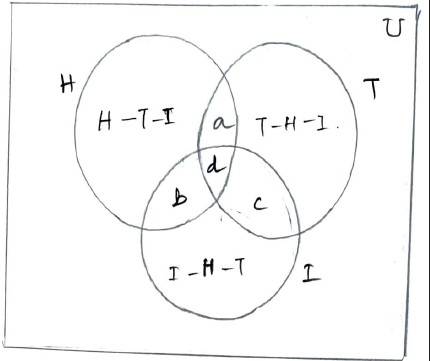Sets
Get insights from 134 questions on Sets, answered by students, alumni, and experts. You may also ask and answer any question you like about Sets
Follow Ask QuestionQuestions
Discussions
Active Users
Followers
New answer posted
4 months agoBeginner-Level 5
The Tamil Nadu Public Service Commission conducted the TNPSC Group 4 exam 2025 on July 12, 2025 at the designated exam centres. The paper was conducted offline where the candidates were required to mark their answers on the OMR sheet provided by the Commission.
The Commission prepared four sets of question paper having identical questions but at different serial number. The candidates were distributed these question papers as per the seating plan prepared and approved by the local exam designated authority.
New answer posted
4 months agoContributor-Level 10
T = {9, 10, 11, 12, …., 1000}
S = {4, 6, 9}
A =
Let 4 appear x no. of times
6 appear y no. of times
9 appear z no. of times
10 then set A has n element 4x + 6y + 9z
Concept : Let a and b are co-prime numbers, then members from (a - ) (b – 1) and more can be expressed in the form ax + by where x, y {0, 1, 2, …}
So, all the number of the form
2y + 3z are (2 1). (3 – 1), ….
i.e., 6, 7, 8, 9, 10, 11, ….
form : 2 + t, t = 0, 1, 2, 3, ….
So, 6y + 9z = 3 (2y + 3z) = 3 (2 + t) = 6 + 3t, t = 0, 1, 2, 3, …
sum of element of T – A is 11
New answer posted
5 months agoContributor-Level 6
Yes, Sandip University employs a normalization process for SU JEE (Sandip University Joint Entrance Examination) scores to ensure fairness across different question paper sets and candidate categories. This process adjusts scores to account for variations in difficulty levels among different exam versions, ensuring that no candidate is unfairly advantaged or disadvantaged due to the specific set of questions they received.
New answer posted
6 months agoContributor-Level 10
66. Given series is 1* 2* 3 + 2* 3 *4 + 3* 4 *5 + … to n term
an = (nth term of A. P. 1, 2, 3, …) ´* (nth terms of A. P. 2, 3, 4) *
i e, a = 1, d = 2- 1 = 1i e, a = 2, d = 3- 2 = 1
(nth term of A. P. 3, 4, 5)
i e, a = 3, d = 3 -4 = 1.
= [1 + (n -1) 1] *[2 + (n -1):1]* [3 + (n- 1) 1]
= (1 + n -1)*(2 + n -1)*(3 + n -1)
= n (n + 1)(n + 2)
= n(n2 + 2n + n + 2)
=n3 + 2n2 + 2n.
Sn = ∑n3 + 3 ∑n2 + 2 ∑n
=
=
New answer posted
6 months agoContributor-Level 10
63. Let H, T and I be of people who reads newspaper H, T and I respectively.
Then,
number of people who reads newspaper H, n (H) = 25.
number of people who T, n (T) = 26.
number of people who I, n (I) = 26
number of people who both H and T, n (HI) = 9
number of people who both H and T, n (H T) = 11
number of people who both T and I, n (TI) = 8
number of people who reads all newspaper, n (HTI) = 3.
Total no. of people surveyed = 60
The given sets can be represented by venn diagram

(i) The number of people who reads at least one of the newspaper.
in (H∪TI) = n (H) + n (T) + n (I) n (HT) n (HI) n (TI) + n (HTI)
= 25 + 26 + 26 11 9 8 + 3
= 80 2
New answer posted
6 months agoContributor-Level 10
62. Let H and E be set of students who known Hindi and English respectively.
Then, number of students who know Hindi = n (H) = 100
Number of students who know English = n (E) = 50
Number of students who know both English & Hindi = 25 = n (HE)
As each of students knows either Hindi or English,
Total number of students in the group,
n (HE) = n (H) + n (E) - n (HE)
= 100 + 25
= 125,
New answer posted
6 months agoContributor-Level 10
61. Let T and C be sets of students taking tea and coffee.
Then, n (T) = 150, number of students taking tea
n (C) = 225, number of students taking coffee
n (TC) = 100, number of students taking both tea and coffee.
So, Number of students taking either tea or coffee is.
n (TC) = n (T) + n (C) n (TC)
= 150 + 225 100
= 275
Number of students taking neither tea coffee
= Total number of students No of students taking either tea or coffee
= 600 275
= 325.
Taking an Exam? Selecting a College?
Get authentic answers from experts, students and alumni that you won't find anywhere else
Sign Up on ShikshaOn Shiksha, get access to
- 65k Colleges
- 1.2k Exams
- 679k Reviews
- 1800k Answers
